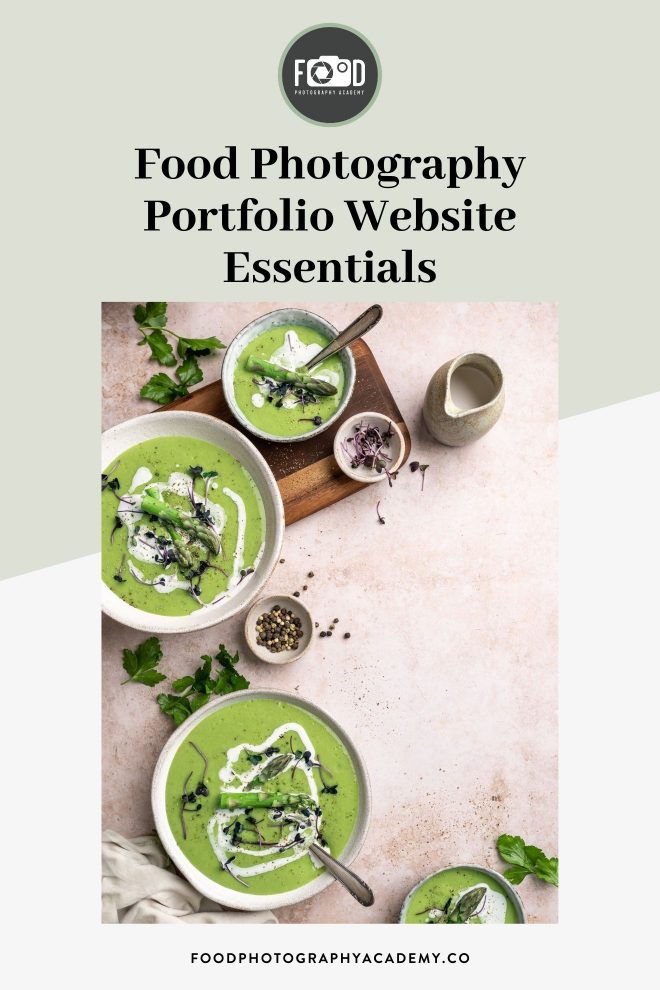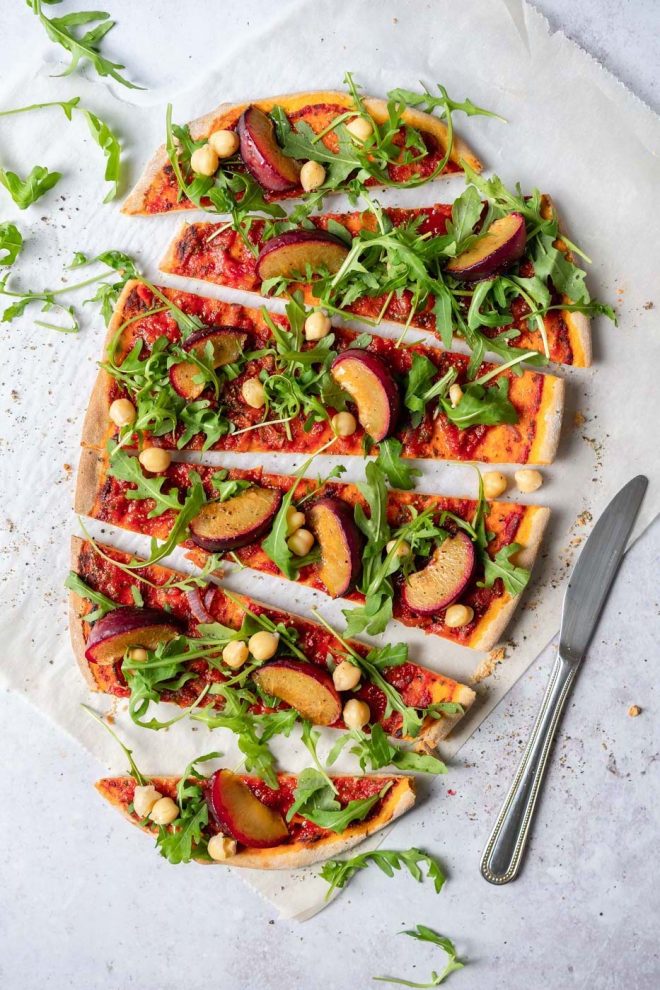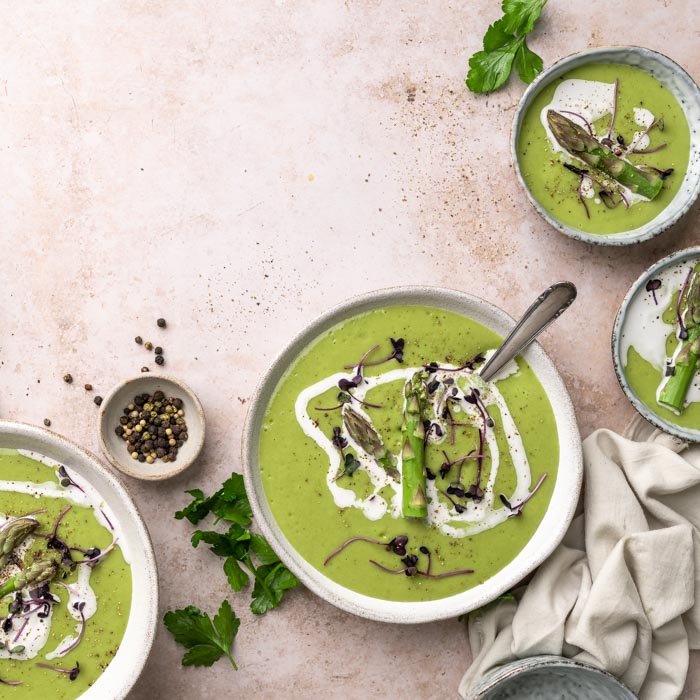Looking to put together a stunning food photography portfolio that will get you hired? This guide explains all.

Why You need a Professional-Level Food Photography Portfolio Website
As a creative professional, the success of your business depends in large part upon how you present yourself. Image and context are ultra important in this industry; you might be hugely talented as a photographer, but if you don’t put your work out there in the right way, you will not realise your full potential in your career.
Although social media platforms are essential for getting your work seen by a lot of people, they can be rather restrictive in terms of branding, layout, and design. So in order to take full control of your public image, you will also need to put together a strong, professional-looking, online food photography portfolio. This will allow you to showcase your work in the best possible light, primarily using social media to draw people to your website.
But what are the most important points to consider when putting together an online food photography portfolio? In this short guide I’ll talk you through the main steps.
Design
Your food photography portfolio has to serve one primary purpose: show off your work and get you jobs. This may seem obvious, but once we get deep into all the decisions involved in putting together a portfolio, we can quickly lose sight of this simple objective.
The design of your food photography portfolio is of course very important, as it plays a big part in establishing you as a professional brand: bad design will make even good photography look cheap. But it’s also important not to get carried away with the design side of things.
In fact, if visitors to your site notice the graphic design at all then it may be a sign that it’s not appropriate for a portfolio website. Even if your style of photography is super quirky and creative, your site probably shouldn’t be. Instead you should go for a design that leaves space for the work to breathe; not one that competes with your photography for attention.
As an example of good design, I really like Rachel Korinek’s portfolio website. It’s clean, modern, and elegant, with just a hint of colour when you hover over the page links. This no-nonsense monochrome design really sets off Rachel’s bold and minimalistic photography very nicely.
It’s also worth paying attention to how optimized your photos are for web display. No one has time for a slow loading site these days, particularly an image heavy portfolio.
Format
While obviously aesthetic considerations are very important, the type of gallery format you choose can also make an enormous difference to how viewers perceive your work. So think very carefully about the layout and navigation of your portfolio website too.
Some photographers go for a single “best-of” style feed, featuring their strongest work all thrown together. For example, with my portfolio site you’re straight into the portfolio the moment you land on the page. This way visitors can quickly gain an overview of my work.
However, many photographers prefer to break their portfolio down into different styles of photography or types of food. For example Skyler Burt has organised his website into separate galleries for savoury dishes, sweets, beverages, and then motion work. This approach can make it easier for a client to see if the kind of photography you do coincides with their needs for a specific job.
Francesco’s Tonelli’s website is even more extreme; almost organised like a restaurant menu. Clearly Francesco has thought about the layout of his portfolio with clients and creatives fully in mind. You want breakfast? A little soup perhaps? Or just potatoes and sides? It’s all here, clearly labelled. And of course the great thing about grouping his photos together in this way is that it shows off his talent for shooting really diverse images of otherwise quite similar subjects.
If I were putting together a moodboard for a shoot and needed to find examples of a specific type of dish, or a particular way of photographing a dish – dark and moody for instance, or light and bright – Francesco’s site allows me to quickly find what I need.
And remember, although a moodboard is theoretically just meant to give a general indication of the art direction for a shoot, by the time a moodboard has been approved, the client has often become psychologically attached to the images it contains. And so frequently it’s the photographers who are featured on the moodboard who get asked to quote for the job. In short, you want your work showing up on as many moodboards as possible, so make it easy for people.
With that said, you should also consider the design of your website from another – and sometimes quite contradictory – perspective. Yes, it’s essential that you consider the needs of potential clients. However, ideally you should also go for a layout that is appropriate to the kind of work that you do, showing it off exactly as it’s meant to be viewed.
For example, if your strength is shooting images that work really well as a series, you probably don’t want to break them up into themed galleries like the examples we’ve looked at above, but should instead keep the narrative fully intact.
The work of NYC-based photography team Peden and Munk is more on the lifestyle and reportage end of food photography. As their greatest strength lies in storytelling, it would make no sense to break these narratives up by showing the images out of context in food-themed galleries like Francesco Tonelli’s. Instead the duo simply have two overall galleries on their site: Motion and Stories, with each of their photo stories shown in its entirety.
Edit
Having just said that, a portfolio website is rarely about showing anything in its entirety. Instead you’ll want to tightly edit your portfolio, so that it contains only the very best of the best.
There are times, though, when even the best won’t do. What I mean is that your portfolio must do more than merely showcase your best work: it should also tell a compelling story about you as a photographer. And occasionally some of your objectively best photos will not fit in with the story that you want to tell. As a professional photographer you are a brand, and every shot in your portfolio must be on-brand. This may mean that a few of your favourite shots don’t make the final edit.
Tearsheets
Instagram is filled with impressive-looking food photography. But many of these photographers are talented amateurs rather than seasoned professionals. Clearly this doesn’t stop them from producing some great images, when the conditions are right. But most clients aren’t willing to take that risk, and instead want to hire proven professionals who will deliver stunning food photography every single time. No excuses.
If you’ve already got some published work to show, then you might want to add this to your website too; tearsheets and final ad layouts will go a long way towards convincing new clients that there’s little risk involved in commissioning you.
It’s worth noting, though, that because magazines and advertising agencies can’t always be relied upon to use our work exactly as we would have wanted, not every photographer chooses to show their tearsheets online. Again, it’s a question of appropriate branding for your style of photography and the market that you’re targeting.

Landing Page
Although some people who visit your portfolio website will already know you and your work, assume that the average visitor doesn’t. But within just a few seconds of landing on your site, first time visitors should be able to understand exactly what makes you special as a photographer.
If you check out the site of Matt Armendariz, you’ll likely notice that one of the things that really sets his work apart is his ability to capture lively and convincing social scenarios based around food. Clearly Matt knows that this is one of his strengths, as aside from having a whole portfolio category on People, it’s also the first thing you’re greeted with when you land on his homepage.
We modern humans have short attention spans, so you need to hook us in right from the start. Make sure that the first few images visitors see on your site are not only among your visually strongest work, but are also typical of the kind of photography you do best.
Bio and Contact Details
Once you’ve won over visitors with the strength of your photography, you also need to convince them that you’re a hardworking professional: not just some chancer who got lucky with a few pretty snaps.
A well-written biography – no matter how short – will go a long way towards reassuring clients that you are a safe proposition, so be sure to include an informative About Me page on your site. Also, it’s surprising how many photographer’s websites are confusing to navigate and don’t make it obvious where to find their contact details – or even fail to mention in which part of the world they are based.
If I were an art director in, say, Stockholm, and working with only a mid-sized budget, I probably wouldn’t be able to fly somebody in from Sydney or LA for a shoot. So the first thing I’ll want to know is whether the producer of all these stunning images is local to me or not. Don’t make it too difficult for people to find the info they need or they’ll just click away in frustration.
Final Thoughts
Hopefully you’ve found these suggestions helpful in putting together a portfolio. Now it’s time for you to get out there, get that portfolio site (that I know has been on your task list forever) DONE, and start getting some work! *virtual fist bump*.

Love your portfolio page Lauren. What format did you use to build it?
I use wordpress 🙂
Could you suggest any free websites where I can develop my photography portfolio?
I’m not sure of any totally free options, my favourite platform is WordPress and that’s what I personally host my portfolio site on!